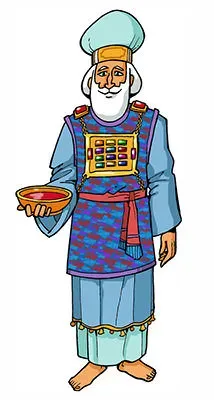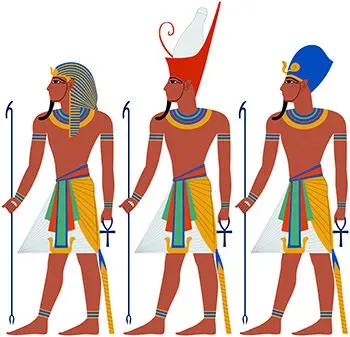 The use of stones to decorate images of the gods, and for use in religious ceremonies to honor the dead, dates back to a remote antiquity. We see this particular use of precious stones as a natural development because of their talismanic powers. If a gemstone was believed to have supernatural powers, then it was, of course, looked upon as the perfect object to decorate a statue of a god, or to place with dead bodies to ensure safe entry of their souls into heaven.
The use of stones to decorate images of the gods, and for use in religious ceremonies to honor the dead, dates back to a remote antiquity. We see this particular use of precious stones as a natural development because of their talismanic powers. If a gemstone was believed to have supernatural powers, then it was, of course, looked upon as the perfect object to decorate a statue of a god, or to place with dead bodies to ensure safe entry of their souls into heaven.
 The earliest record of this use of gemstones for religious purposes comes from Egypt, and concerns the custom of engraving words from a composition called the "Book of the Dead"" onto semi-precious stones, which were cut into various symbolic forms. This ""Book of the Dead"" was made up of many chapters. Each chapter was almost like a complete book. The chapters described the journey of the soul of the dead through the various realms of the dead. In this book, the soul speaks to the gods as well as any other beings who listen. The prayers written in the chapters are supposed to ensure a safe passage to heaven, with protection from any evil spirits."
The earliest record of this use of gemstones for religious purposes comes from Egypt, and concerns the custom of engraving words from a composition called the "Book of the Dead"" onto semi-precious stones, which were cut into various symbolic forms. This ""Book of the Dead"" was made up of many chapters. Each chapter was almost like a complete book. The chapters described the journey of the soul of the dead through the various realms of the dead. In this book, the soul speaks to the gods as well as any other beings who listen. The prayers written in the chapters are supposed to ensure a safe passage to heaven, with protection from any evil spirits."
 Another amulet is the tet. The hieroglyph represents a mason's table and the word signifies "firmness, stability, preservation."" These figures, made of faience, gold, carnelian,
Another amulet is the tet. The hieroglyph represents a mason's table and the word signifies "firmness, stability, preservation."" These figures, made of faience, gold, carnelian, ![]() lapis-lazuli, and other materials, were placed on the neck of the mummy to provide protection."
lapis-lazuli, and other materials, were placed on the neck of the mummy to provide protection."
 The "papyrus scepter,"" uat, is usually cut from matrix-
The "papyrus scepter,"" uat, is usually cut from matrix-![]() emerald or made of faience of a similar hue. U at means ""verdure, flourishing, greenness,"" and placed on the neck of the mummy, it represented the eternal youth the deceased would enjoy in the realm of the dead. An uat of matrix-emerald in the 159th chapter of the ""Book of the Dead"" is written about. It was a gift from Thoth, and protected the limbs of the deceased."
emerald or made of faience of a similar hue. U at means ""verdure, flourishing, greenness,"" and placed on the neck of the mummy, it represented the eternal youth the deceased would enjoy in the realm of the dead. An uat of matrix-emerald in the 159th chapter of the ""Book of the Dead"" is written about. It was a gift from Thoth, and protected the limbs of the deceased."
 Ab, an amulet in the shape of a heart, was the kind of amulet most frequently used. Abs were made of basalt,
Ab, an amulet in the shape of a heart, was the kind of amulet most frequently used. Abs were made of basalt, ![]() lapis lazuli, green
lapis lazuli, green ![]() jasper, and carnelian, amongst other hard materials. In ancient Egypt, the heart was regarded as the seat of life, and was the object of special care after death. After a person had died, an ab was placed in a special container and buried with the mummy. Egyptians believed that after the ab was weighed in the balance of the underworld, it could take its place back into the body of the deceased. The heart was represented by the scarab.
jasper, and carnelian, amongst other hard materials. In ancient Egypt, the heart was regarded as the seat of life, and was the object of special care after death. After a person had died, an ab was placed in a special container and buried with the mummy. Egyptians believed that after the ab was weighed in the balance of the underworld, it could take its place back into the body of the deceased. The heart was represented by the scarab.